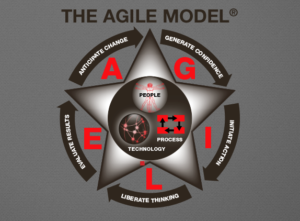Leadership & Management71
Driving Organizational Performance Through Leadership Agility
An interview with Nick Horney
Isabella Serg, Nick Horney, Ph.D.
March 3, 2018
An interview with Nick Horney
Isabella Serg, Nick Horney, Ph.D.
March 3, 2018

Interview by Isabella Serg
In today’s turbulent business environment, leaders with the ability to anticipate change and make fast and effective performance decisions can enable high performing teams that drive organizational agility.
I got a chance to catch up with Dr Nick Horney, the founder of Agility Consulting and Training, to get his thoughts on improving operational performance through leadership agility in a VUCA (Volatile, Uncertain, Complex and Ambiguous) world.
Nick explains the behaviors and competencies underlying leadership agility and how Human Resources (HR) can fundamentally reshape itself and the tools it uses to identify and develop these capabilities in its leaders.
What are the characteristics and behaviors of an agile leader, and why is this important in a VUCA world?
Being focused, fast and flexible is the goal of being agile as a leader, a team or as an organization. It doesn’t mean you can only be focused, you can only be fast or you can only be flexible; you need to achieve all three of these and that’s done through The AGILE Model®.
It’s important to clearly distinguish between agile leadership and leadership agility. Leadership agility is much more about the distinction between the kinds of behaviors and competencies built into leadership agility, perhaps different from agile leadership of actually applying agile techniques. It’s an argument that’s part of a presentation I made at the Agile Alliance conference a few years ago about being agile versus doing agile. Being agile as a leader means demonstrating the five drivers represented by The AGILE Model®:
The AGILE Model® is the only research-based model for Leadership Agility with over 2000 global leaders participating in data gathering through the 75-item Leadership Agility Profile™ for over a decade.
How can HR support the development of leadership agility? What tools and methods do they have in their toolkit?
The world of work is dramatically changing; HR needs to do several things in terms of transforming itself. The best quote comes from Jack Welch, former CEO of GE: “when the rate of change outside exceeds the rate of change inside, the end is in sight”. HR needs to constantly look at the business environment and ask: what’s happening with business disruption (e.g., digital, demographic, global, security, etc.) and how can we, as a function, implement leadership, team and organizational agility in our company?
The reality is, the way work is getting done now in this Gig Economy is not only through full-time staff but also through contingent employees. How do we onboard them? How do we engage them so they’re a trusted part of the entire delivery team? Instead of relying on the annual process of doing talent reviews, why not align that process with scenario planning so you’re literally looking at talent based on different business scenarios? Each of those scenarios may mean that you need a different mix of talent to be able to address that scenario. This would enable an organization to shift much faster to a new scenario if the assumptions they built into their strategy are not playing out.
In terms of attracting, engaging and retaining key talent, how do both leadership and HR need to change to enable organizations to compete successfully in a VUCA world?
The first thing for HR to do is to step back and ask itself: how does work get done in our organization? What percentage of work is done by contingent workers compared to full-time staff and is that shifting? If it is shifting, HR needs to think about how it then starts developing leaders in an organization to be able to lead workers, not just employees. LinkedIn is probably the most recent example of being able to provide another platform to those who are more interested in contingent or gig-type work to successfully connect with companies that are hiring these types of workers.
With that said, HR needs to step up to the plate and understand the trends and patterns in the dynamically changing marketplace. They need to look at the HR programs and policies currently in place that don’t address the contingent workforce or how work is going to get done in the future and rewrite these.
Tell me a little bit about The AGILE Model® and the results organizations have seen using this method.
 When you talk about results, if you can go back and look at that through the lens of The AGILE Model®, usually the marketplace
When you talk about results, if you can go back and look at that through the lens of The AGILE Model®, usually the marketplace
issues that are faced by an organization include some form of disruption from business as usual. Let’s say for example that an organization is surprised that a key supplier is no longer in business or decides to supply to a competitor. Or key high potential talent suddenly leaves and goes to work for competitors. Part of our challenge to the organization is to ask: what is it doing to anticipate change? We push to find out how they are looking at trends and patterns and scenario planning as they build out their strategy. And if they’re not, more than likely they will be surprised. The AGILE Model® is a multi-disciplinary framework that enables organizations to be pre-emptive and proactive in their actions as well as responsive to a continuously changing VUCA business environment.
You are speaking at the Business Agility Conference in New York City on 23-24 February. What can audiences expect to learn from your presentation?
I want to challenge everybody’s thinking or assumption that agile leadership is just taking agile methodologies and applying them in as many places as possible. It’s bigger than that. That’s why my discussion on leadership agility is focused on the research-based leadership behaviors represented by The AGILE Model®. So I’ll share a bit about the VUCA world and the external challenges that are impacting every organization which are causing the demand for leadership agility. I’ll share examples of how CEOs and their organizations have dealt with the implementation of leadership agility to help transform their companies to become more agile.
Dr. Nick Horney founded Agility Consulting and Training in 2001 and has been recognized for innovations in organizational and leadership agility which includes The AGILE Model®. Nick combines his background as a psychologist, author, researcher and consultant with his 23 years in Navy Special Operations where leading high performance agile teams was a daily activity.
Please subscribe and become a member to access the entire Business Agility Library without restriction.